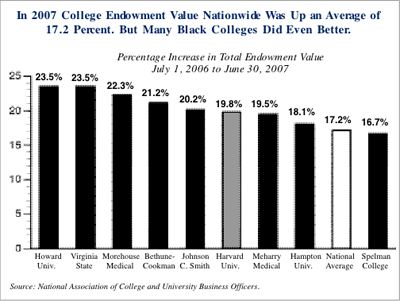| Black Colleges and Universities Show Impressive Endowment Growth College endowments on the whole experienced an average increase of nearly 17.2 percent in the July 1, 2006 to June 30, 2007 period. Traditionally, the endowment funds of black colleges and universities tend to lag the performance of their predominantly white peers. But in the latest reporting period several of the nation’s black colleges and universities beat the national average. Several black colleges even bested the performance in the growth of the behemoth endowment of Harvard University. Among the giant funds, the University of Notre Dame posted an impressive gain of 34.7 percent in the July 1, 2006 to June 30, 2007 period, more than doubling the average growth of endowment funds nationwide. Duke University and the University of North Carolina at Chapel Hill both posted gains of more than 30 percent. The historically black colleges and universities traditionally achieve smaller than average gains in their endowment funds. For the most part, the endowment funds of black colleges and universities are not as heavily invested in equities as is the norm for most predominantly white institutions. Many black colleges greatly rely on endowment yield to fund current operations, which at most black colleges requires an annual return from a fixed portion of their endowment fund. Therefore, endowment funds of the black colleges and universities are often heavily invested in government securities and other investments carrying little risk — securities that will produce a small but secure revenue stream. This investment strategy shelters these endowment funds from large losses in down markets but also provides lower returns in periods when stocks are rising.
Spelman College, with an endowment of $340,261,000, had the second-largest fund among the black institutions. For the year ending June 30, 2007, Spelman’s endowment fund increased nearly 17 percent over a year earlier. This gain is just below the national average. Hampton University in Virginia had endowment resources of $257 million as of June 30, 2007. Hampton’s endowment grew by 18.1 percent from the earlier year. This bested the average gain posted by the endowment funds for all colleges and universities nationally. There were several other historically black institutions in the NACUBO survey that outperformed the average for all colleges and universities in the nation. For the third year in a row, Meharry Medical College in Nashville saw its endowment increase by a large percentage. In the most recent period, the medical school saw its endowment increase by 19.5 percent. The Morehouse School of Medicine also saw major gains over the past three years. In the latest yearly period, the endowment grew 22.3 percent to $56.4 million. Bethune-Cookman University saw its endowment in-crease by 21.2 percent in the July 1, 2006 to June 30, 2007 period. The previous year, the endowment at Bethune-Cook-man grew by 22 percent. The university’s endowment now stands at $42.9 million. Virginia State University posted a 23.5 percent increase in endowment value over the previous year. It is important to remember that the endowments of many historically black colleges and universities remain tiny. Consider that Spelman College, which, as mentioned, ranks second to Howard University among the black colleges, has an endowment that is less than one percent of the value of the fund at Harvard University. *Data collected by NACUBO is for total endowment value. In most cases endowment fund growth includes returns on investment of the fund balance as well as new contributions. Fund drives, major gifts, and spending can all impact endowment fund value. |
|




 But in the latest annual reporting period, many of the historically black colleges and universities outperformed the nation’s wealthiest universities in endowment growth. Howard University continues to have the largest endowment of any black college or university. As of June 30, 2007, its endowment stood at $523,690,000. This was a whopping increase of 23.5 percent from a year earlier. In size, Howard’s endowment ranks 138th in the nation, just ahead of Colorado College, the small, highly selective liberal arts college in Colorado Springs.
But in the latest annual reporting period, many of the historically black colleges and universities outperformed the nation’s wealthiest universities in endowment growth. Howard University continues to have the largest endowment of any black college or university. As of June 30, 2007, its endowment stood at $523,690,000. This was a whopping increase of 23.5 percent from a year earlier. In size, Howard’s endowment ranks 138th in the nation, just ahead of Colorado College, the small, highly selective liberal arts college in Colorado Springs.